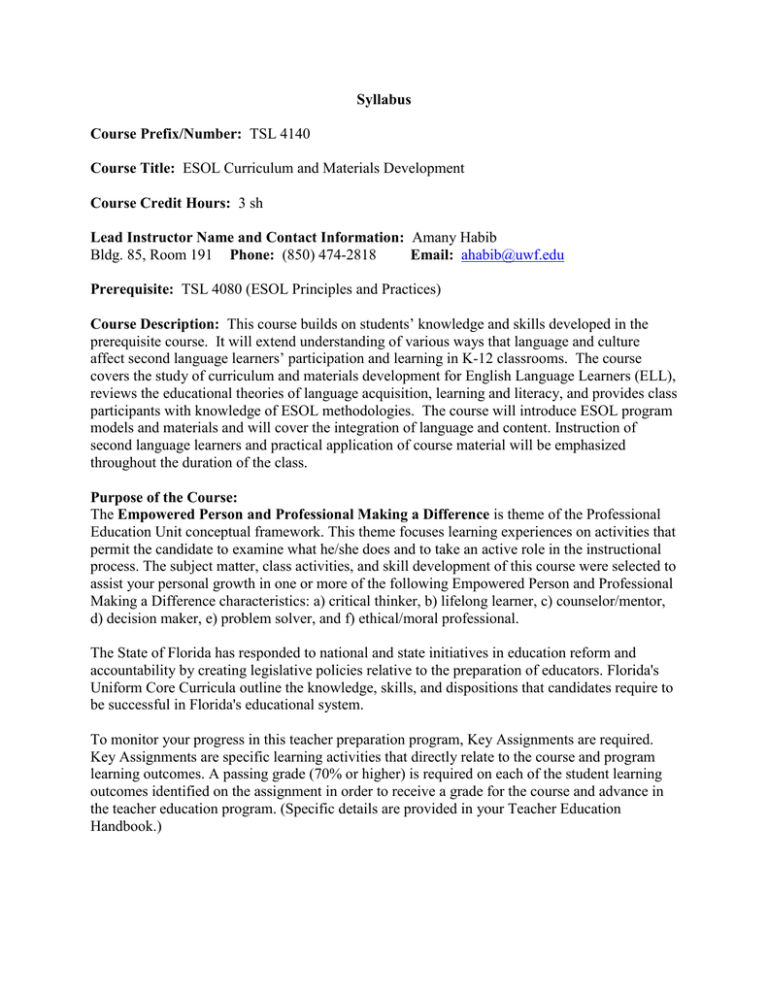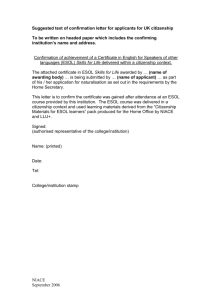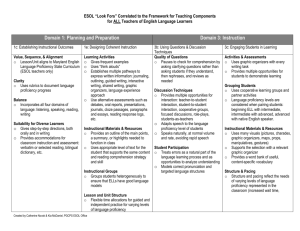Syllabus Course Prefix/Number: TSL 4140 Course Title: ESOL
advertisement

Syllabus Course Prefix/Number: TSL 4140 Course Title: ESOL Curriculum and Materials Development Course Credit Hours: 3 sh Lead Instructor Name and Contact Information: Amany Habib Bldg. 85, Room 191 Phone: (850) 474-2818 Email: ahabib@uwf.edu Prerequisite: TSL 4080 (ESOL Principles and Practices) Course Description: This course builds on students’ knowledge and skills developed in the prerequisite course. It will extend understanding of various ways that language and culture affect second language learners’ participation and learning in K-12 classrooms. The course covers the study of curriculum and materials development for English Language Learners (ELL), reviews the educational theories of language acquisition, learning and literacy, and provides class participants with knowledge of ESOL methodologies. The course will introduce ESOL program models and materials and will cover the integration of language and content. Instruction of second language learners and practical application of course material will be emphasized throughout the duration of the class. Purpose of the Course: The Empowered Person and Professional Making a Difference is theme of the Professional Education Unit conceptual framework. This theme focuses learning experiences on activities that permit the candidate to examine what he/she does and to take an active role in the instructional process. The subject matter, class activities, and skill development of this course were selected to assist your personal growth in one or more of the following Empowered Person and Professional Making a Difference characteristics: a) critical thinker, b) lifelong learner, c) counselor/mentor, d) decision maker, e) problem solver, and f) ethical/moral professional. The State of Florida has responded to national and state initiatives in education reform and accountability by creating legislative policies relative to the preparation of educators. Florida's Uniform Core Curricula outline the knowledge, skills, and dispositions that candidates require to be successful in Florida's educational system. To monitor your progress in this teacher preparation program, Key Assignments are required. Key Assignments are specific learning activities that directly relate to the course and program learning outcomes. A passing grade (70% or higher) is required on each of the student learning outcomes identified on the assignment in order to receive a grade for the course and advance in the teacher education program. (Specific details are provided in your Teacher Education Handbook.) Student Learning Outcomes: Upon completion of this course, students will be able to: 1. Select and develop appropriate ESOL content according to student levels of proficiency in listening, speaking, reading, and writing, taking into account basic interpersonal communication skills (BICS) and cognitive academic language proficiency (CALP) of individual students. 2. Reflect respect for diverse perspectives, ideas, and opinions in planned learning activities. 3. Become aware of the wide diversity within different cultural groups and use cultural information without depending on stereotypes and preconceived ideas concerning cultural characteristics. 4. Use technology in lesson and material preparation. 5. Utilize instructional approaches and techniques that integrate language and curricular content learning for teaching English to speakers of other languages. 6. Understand, evaluate, adapt, and use a variety of instructional materials, media and technology for ESOL and content area instruction. 7. Evaluate, design, and employ instructional methods and techniques appropriate to learners’ socialization and communication needs, based on knowledge of language as a social phenomenon. 8. Evaluate, select and employ appropriate instructional materials, media, and technology for ESOL at elementary, middle, and high school levels. 9. Design and implement effective unit plans and daily lesson plans which meet the needs of ESOL students within the context of the regular classroom. 10. Assume instructional and leadership roles in teaching English to speakers of other languages with an understanding of ESOL curriculum materials and how they are developed. Goals: The State of Florida has responded to national and state initiatives in education reform and accountability by creating legislative policies relative to the preparation of teachers. Florida’s Accomplished Practices, Sunshine State Standards, and Curriculum Framework outline the knowledge, skills, dispositions and knowledge-base that teachers and students require to be successful in Florida’s educational system. Within diverse learning environments, teachers require skills in and knowledge of classroom management techniques. Specific goals of this course are: - To prepare students to pass items related to Competencies and Skills Required for Teacher Certification in Florida. http://www.firn.edu/doe/sas/ftce/pdf/ftcomp47.pdf - To prepare students to meet the following Accomplished Practices mandated by the state of Florida: #2, 3, 4, 5, 6, 7, 8, 9, 10, 11 (www.firn.edu.doe) - To prepare students to meet standards #1, 2, 3, and 5 set by the National Board for Professional Teaching Standards. http://www.nbpts.org/nbpts/standards/five-props.html - To prepare students to use appropriate Sunshine State Standards in teaching ELL students http://www.firn.edu/doe/curric/prek12/frame2.htm Competency Alignment Matrix: Project Name and Assessment Tool Conceptual Course NCATE Framework Outcomes SLOs Standard (Characteristics) 1 Indicator Critical Thinker 1, 2, 1c Decision Maker 3, 7 Ethical/Moral Professional FEAPs (professional) Teaching Strategies Project Critical Thinker Ethical/Moral Professional 1, 6 1c Methods and Approaches power point Content Lesson Plan Ethical/Moral Professional 4, 5, 6, 7, 8 1c 1.1, 1.4, 2.3, 2.5, 2.8, 4.6, 5.1, 5.3, 5.4, 5.5, 5.6, 5.9, 7.4, 7.5, 7.6, 9.10, 10.6, 9.10 3.8, 7.4, 9.4, 9.10 Counselor and Mentor 4, 5, 9, 10 1c Midterm – Essay Test Ethical/Moral Professional 7, 10 1c Final - Essay Test Ethical/Moral Professional 7, 10 1c Weekly Assignments and Discussions Topics Covered: 1.1, 1.4, 2.10, 4.6, 5.1, 5.3, 5.4, 7.6, 9.4, 11.1, 11.10 1.1, 1.4, 5.4, 5.6, 7.4, 7.5, ESOL Performance Standards 2.1, 2.2, 4.1 4.3, 6.3, 6.8 6.9 ,6.10, 7.1, 7.4, 8.1 8.3, 8.4,8.5 9.2, 9.3, 9.4 9.5, 9.6, 9.7 12.1, 12.2, 12.5, 13.1, 13.2, 13.4, 13.5, 13.7, 15.1, 15.2, 15.3, 15.4, 15.5, 15.6, 16.2, 16.3, 17.2, 17.3, 17.4,17.5, 18.1, 25.1 5.4, 6.3, 6.4 6.10, 11.1, 11.2, 11.3, 11.4, 13.3, 18.4 6.1, 6.2, 6.4, 6.5, 6.6, 7.2, 9.1, 16.1 4.3, 5.4, 6.6, 8.2, 9.3, 11.5, 12.3, 12.4, 13.7, 17.1, 17.5, 24.1 6.8 6.10 7.1 7.4 12.3, 13.1, 15.6, 17.5, 25.1 1. Introduction, review of prerequisite course material and ESOL terminology 2. Multicultural issues in teaching English as a second language 3. Multicultural issues in teaching English as a second language, cont. and Strategies for teaching English Language Learners 4. Teaching for communication 5. Historical overview of the methods and approaches in teaching ESOL 6. Principles of Communicative Language Teaching 7. Organizing and Planning: Integration of Language and Content 8. Curriculum Design and Day-to-Day instruction 9. Instruction and Development of Oral Language and Vocabulary 10. Instruction and Development of Reading and Writing 11. Teaching English through content: Mathematics and Science 12. Social Studies and teaching ESOL through Music, Drama, and Art 13. Linguistically Diverse Students and Special Education & using technology Tentative Schedule: Please see separate module for class schedule. Required Texts: Zainuddin, H., Yahya, N., Morales-Jones, C. and Ariza, E. 2007. Fundamentals of teaching English to Speakers of Other Languages in K-12 Mainstream Classrooms. 3rd ed. Dubuque: Kendall/Hunt Publishing. Herrell, A.L. and Jordan, M. Fifty Strategies for Teaching English Language Learners. 4th ed. Upper Saddle River: Pearson/Merrill Prentice Hall. Also required: TK20 Subscription available directly at http://uwf.tk20.com or through the UWF campus bookstore - Student Access Kits (ISBN 0-9774408-1-8) Relevant Websites: International Reading Association www.reading.org International TESOL organization www.tesol.org Florida state TESOL organization www.sunshine-tesol.org Office of Multicultural Student Language Education www.fldoe.org Publications: www.eslmag.com and www.handsonenglish.com Activity sites: www.esllessons.edu and www.onechild.com and www.helloamerica.com Recommended Resources: “TESOL Journal” “Sunshine State TESOL Journal” “The Messenger” A publication of Sunshine State TESOL of Florida “TESOL Matters” A publication of Teachers of English to Speakers of Other Languages Grading / Evaluation: Note: Key Assignments/critical tasks must be submitted in TK20. You must earn 70% or better on the identified student learning outcomes of this assignment to pass this course and continue in this Teacher Education program Discussions Teaching Strategies Project Methods and Approaches power point Content Lesson Plan Midterm Final Exam Total 15 points 15 points 15 points 15 points 10 points 30 points 100 points ASSIGNMENT DESCRIPTIONS/GRADE DETERMINATION: 1. 2. 3. 4. Discussions - There will be 5 different discussion topics associated with many of the 24 Chapters in the main textbook. Students gain 3 points each for responding to these discussions. Teaching Strategy Project - Students will select one strategy from sections II, III, IV, and V from the Fifty Strategies for Teaching English Language Learners (2nd textbook –see above). Develop a brochure for each which could be used as a useful reminder to you of these important and helpful strategies as well as a resource you can share with other teachers in your current or future school. Your brochures should include a good description of the strategies, specific ideas for using them, and a convincing statement of their effectiveness. If a strategy requires the use of certain materials, you should include those as well. In addition to the four brochures, you should write a long paragraph at the end in which you explain your choices and give reasons why you chose these particular strategies. This is in addition to a personal reflection about the use of different strategies and their effect on ELLs. Methods/Approaches PowerPoint Presentation - Students choose one of the eight methods/approaches listed in chapter 11 of the first textbook. Research it briefly and describe it. Then from chapter 13, select one of the current approaches, research it and explain it in depth. Develop a presentation of how this current method/approach would be used with ELLs. The presentation should include: 1) A basic background and explanation of each method/approach (the text is a good resource and the internet could provide you with additional information) 2) A brief comparison of how the two differ 3) A short demonstration of an activity/lesson that can utilize the current method/approach. 4) A description of the appropriate materials needed to demonstrate the method/approach (visuals, handouts, etc.) 5) Your thoughts regarding the usefulness of the current approach. Content Lesson Plan - Students prepare a lesson plan which covers about 50-60 minutes (can be longer but you need to get instructor’s approval ahead of time) on one of the content areas listed in Chapters 21-24 of the text. The Lesson Plan should include: 1) 2) 3) 5. 6. Grade level/age group, Content area, Objectives, etc. A detailed description of the lesson in the content area (how it will be delivered) Highlighted demonstrations of accommodation, modification, and adaptations which you made for ELL students. These need to be provided through out the plan and not only at the end. 4) Appropriate materials for activities, etc should be included if possible or described in detail. (Visuals, activities, etc.) Include any additional information necessary to your specific plan. Midterm - Students complete an essay test which includes 2 questions related to materials covered up to that point. Final Exam - Students prepare for exam by reviewing all their notes, assignments, and books prior to the time of the exam. You will have to answer 3 questions in 2 hours. You are allowed 1 attempt during the 24 hours this exam is available on e-learning. Due dates for the assignments are offered in the class schedule. See separate module. Grading Scale A = 100-96 B- = 84-82 D+ = 71-68 A- = 95-92 C+ = 81-78 D = 67-65 B+ = 91-88 B = 87-85 C = 77-75 C- = 74-72 F = 64 or below References/Bibliography: Ariza, E., Morales-Jones, C., Yahya, N., and Zainuddin H. (2000). Why TESOL? Theories and Issues in Teaching English as a Second Language for K-12 Teachers. University, Dubuque, Kendall/Hunt. Flaitz et al. (2003). Understanding your International Students: An educational, cultural, and Linguistic Guide. Ann Arbor : University of Michigan Press. Fromkin, V., Rodman, R., and Hyams, N. (2003). Introduction to Language. 7th Ed. Boston : MA. Thomson/Heinle. Omaggio Hadley, A. (2001). Teaching Language in Context. 3rd Ed. Boston: MA. Heinle & Heinle/Thomson Learning. Dept. of Education, State of Florida, Empowering ESOL Teachers: An Overview, Section 8, “Integrating Language, Literacy, Culture and Content Instruction” Bachman, L.F. (2008). Fundamental Considerations in Language Testing. New York, NY: Oxford University Press Peregoy, S.F. and Boyle, O.F. (2001). Reading, Writing and Learning in ESL: A resource book for K-12 Teachers. New York: Addison Wesley Longman, Inc. Echevarria, J. & Graves, A. (2003). Sheltered instruction: Teaching English-Language Learners with diverse abilities. (2nd ed) Boston, MA: Pearson. Haley, M. H. & Austin, T. Y. (2004). Content-based second language teaching and learning: An interactive approach. Boston, MA: Pearson. Piper, Terry. (1998). Language and Learning, The Home and School Years. Upper Saddle River, Merrill Prentice Hall. (Chapter 2, Linguists and Language) Davidman, Leonard and Davidman, Patricia1997.Teaching with a Multicultural Perspective A Practical Guide. New York : Longman. Garcia, E. (2000). Student Cultural Diversity Understanding and Meeting the Challenge. Boston: Houghton Mifflin Company. Gebhard, J. G. (2000). Teaching English As A Foreign or Second Language. Ann Arbor: Univ. of Michigan Press. Lessow-Hurley, J. (2000). The Foundations of Dual Language Instruction. New York: Longman. Manning, M. L. & Baruth, L. G. (2000). Multicultural Education of Children and Adolescents. Boston: McGraw Hill. Peyton, J. K. & Reed, L. (1990). Dialogue Journal Writing with Nonnative English Speakers: A Handbook for Teachers. Alexandria, VA: TESOL Robertson, Judith P. Ed. 1999. Teaching for a Tolerant World Essays and Resources. Urbana, IL: NCTE. Special Technology Utilized by Students: Each UWF Student is expected to: Activate a UWF ArgoNet email account Access email two to three times weekly Have basic word processing knowledge Purchase and activate a TK20 account Plagiarism Policy: (Word Format) | (PDF Format) | (RTF Format) Student Handbook: (PDF Format) Statement of the University Policy on Academic Conduct: The Student Code of Conduct sets forth the rules, regulations and expected behavior of students enrolled at the University of West Florida. Violations of any rules, regulations, or behavioral expectations may result in a charge of violating the Student Code of Conduct. It is the student’s responsibility to read the Student Code of Conduct and conduct themselves accordingly. You may access the current Student Code of Conduct at http://www.uwf.edu/judicialaffairs. Expectations for Academic Conduct/Plagiarism Policy: Academic Conduct Policy: (Web Format) | (PDF Format) (RTF Format) Assistance: Students with special needs who require specific examination-related or other course-related accommodations should contact the Student Disability Resource Center (SDRC), sdrc@uwf.edu, 850.474.2387. SDRC will send an email to the instructor that specifies any recommended accommodations. UWF TurnItIn notice: UWF maintains a university license agreement for an online text matching service called TurnItIn. At my discretion I will use the TurnItIn service to determine the originality of student papers. If I submit your paper to TurnItIn, it will be stored in a TurnItIn database for as long as the service remains in existence. If you object to this storage of your paper: 1. You must let me know no later than two weeks after the start of this class. 2. I will utilize other services and techniques to evaluate your work for evidence of appropriate authorship practices. Syllabus Notice of Change: Although this syllabus is intended for multiple audiences and incorporates the minimum course criteria, the content of this syllabus may change based on individual instructor’s specifications. Any modifications to this syllabus will be announced during the first week of the semester. ESOL Standards: 1. Conduct ESOL programs within the parameters, goals and stipulations of the Florida Consent Decree. 2. Recognize the major differences and similarities between the different cultural groups in the United States. 3. Identify, expose and re-examine cultural stereotypes relating to LEP and non-LEP students. 4. Use knowledge of the cultural characteristics of Florida's LEP population to enhance instruction. 5. Determine and use appropriate instructional methods and strategies for individuals and groups, using knowledge of first and second language acquisition processes. 6. Apply current and effective ESOL teaching methodologies in planning and delivering instruction to LEP students. 7. Locate and acquire relevant resources in ESOL methodologies. 8a.. Present appropriate content according to student levels of proficiency in listening, speaking, reading and writing. 8b. Understand and plan for a wide range of language functions that students must perform in mainstream classrooms, both social and academic. 9. Develop experiential and interactive literacy activities for LEP students, using current information on linguistic and cognitive processes. 10. 11. 12. 13. 14. 15. 16. 17. 18. 19. 20. 21. 22. 23a. 23b. 24. 25. Analyze student language and determine appropriate instructional strategies, using knowledge about phonology, morphology, syntax, semantics and discourse. Apply essential strategies for developing and integrating the four language skills of listening comprehension, oral communication, reading and writing. Apply content-based ESOL strategies to instruction. Evaluate, design and employ instructional methods and techniques appropriate to learners' socialization and communication needs, based on knowledge of language as a social phenomenon. Plan and evaluate instructional outcomes, recognizing the effects of race, gender, ethnicity, socioeconomic status and religion on the results. Evaluate, select and employ appropriate instructional materials, media and technology for ESOL at elementary, middle and high school levels. Design and implement effective unit plans and daily lesson plans to meet the needs of LEP students within the context of the regular classroom. Evaluate, adapt and employ appropriate instructional materials, media and technology for ESOL in the content areas at elementary, middle and high school levels. Create a positive classroom environment to accommodate the learning styles and cultural backgrounds of students. Consider current trends and issues related to the testing of linguistic and culturally diverse students when using testing instruments and techniques. Administer tests and interpret test results, applying basic measurement concepts. Use formal and informal methods of assessment/evaluation of LEP students, including measurement of language, literacy and academic content metacognition, Develop and implement strategies for using school, neighborhood and home resources in the ESOL curriculum. Identify major attitudes of local target groups toward school, teachers, discipline and education in general that may lead to misinterpretation by school personnel. Identify ways to reduce cross-cultural barriers between students, parents and the school setting. Develop, implement and evaluate instructional programs in ESOL, based on current trends in research and practice. Recognize indicators of learning disabilities, especially hearing impairment (and dyslexia), as they relate to limited English proficiency.






